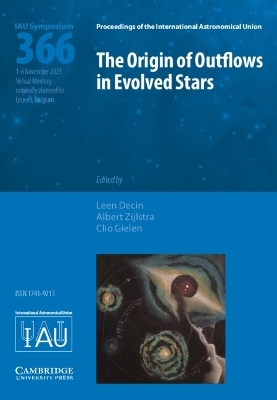
The Origin of Outflows in Evolved Stars (IAU S366)
Cambridge University Press (Verlag)
978-1-108-49079-5 (ISBN)
The prime parameter determining the evolution of a star is its mass. Any modification to the stellar mass has large repercussions on its evolutionary path. Both low-mass and massive stars are known to power strong stellar winds at the end of their lives. These winds determine the type of the stellar end product and the amount by which these stars contribute to the chemical enrichment of the interstellar medium, ultimately providing the building blocks of planets and life. A proper understanding of stellar evolution and the building blocks in the Universe cannot be achieved without a detailed understanding of stellar winds. IAU Symposium 366 provides an overview of state-of-the-art observational and theoretical studies on the origin of winds in low-mass and massive evolved stars, with topics including binarity, enrichment of the interstellar medium, astrochemistry, and theoretical, observational and numerical constraints on stellar outflows.
Preface; Getting started: how a supersonic stellar wind is initiated from a hydrostatic surface; The first 3D models of evolved hot star outflows; The origin and impact of Wolf-Rayet-type mass loss; Magnetised gas nebulae of evolved massive stars; Can pre-supernova winds from massive stars enrich the interstellar medium with nitrogen at high redshift?; Effects of wind mass-loss on the observational properties of type Ib and Ic supernova progenitors; Environments of evolved massive stars: evidence for episodic mass ejections; How did the stellar winds of massive stars influence the surrounding environment in the Galactic Center?; The role of mass loss in chemodynamical evolution of galaxies; The interplay between mass-loss and binarity; The link between hot and cool outflows; Atmospheric structure and dynamics of evolved massive stars thanks to 3D radiative hydrodynamical simulations of stellar convection; The Great Dimming of Betelgeuse from the VLT/VLTI; The inner dust shell of Betelgeuse seen with polarimetry; Analytic, turbulent pressure driven mass loss rates from red supergiants; Multiple shell ejections on a 100 yr timescale from a massive yellow hypergiant; BOSS-3D: a binary object spectral synthesis code in 3D; Simulations of colliding winds in massive binary systems with accretion; Mass loss from binary stars approaching merger; Explaining the winds of AGB stars: Recent progress; The onset of mass loss in evolved stars; The distribution of carbonaceous molecules and SiN around the S-type AGB star W Aquilae; Long-term light curve variations of AGB stars: episodic mass-loss or binarity?; MATISSE first pictures of dust and molecules around R Sculptoris; Tracing the role of AGB stars in the Galactic fluorine budget; Tracing the inner regions of circumstellar envelopes via high-excitation water transitions; Detailing evolved star wind complexity: comparing maser and thermal imaging; Mass-loss rates of cool evolved stars in M33 galaxy; Shaping the initial-final mass relation of white dwarfs with AGB outflows; Mass transfer in AGB binaries: uncovering a new evolution channel by 3D radiation-hydrodynamic simulations; Route towards complete 3D hydro-chemical simulations of companion-perturbed AGB outflows; 3D hydrodynamical survey of the impact of a companion on the morphology and dynamics of AGB outflows; Morpho-kinematics around cool evolved stars unveiling the underlying companion; Accretion-powered Outflows in AGB Stars; Learning about AGB stars by studying the stars polluted by their outflows; Tc-rich M stars: platypuses of low-mass star evolution; The impact of UV photons from a stellar companion on the chemistry of AGB outflows; Chemistry on hot astrochemical dust surfaces: sulfur in AGB outflows; Circumbinary discs around post-AGB binaries as a result of binary interactions: an infrared interferometric view; Pre-planetary nebulae: A context for principles, progress, and questions on how binaries and magnetic fields produce jets; ALMA (finally!) discloses a rotating disk+bipolar wind system at the centre of the wind-prominent pPN OH231.8+4.2; Lessons from the ionised and molecular mass of post-CE PNe; Outflows and disks in post-RGB objects: products of common envelope ejection?; RGB mass loss: inferences from CMD-fitting and asteroseismology; Towards the identification of carriers of the unidentified infrared (UIR) bands in novae; Author index.
| Erscheinungsdatum | 19.01.2023 |
|---|---|
| Reihe/Serie | Proceedings of the International Astronomical Union Symposia and Colloquia |
| Zusatzinfo | Worked examples or Exercises |
| Verlagsort | Cambridge |
| Sprache | englisch |
| Maße | 179 x 254 mm |
| Gewicht | 720 g |
| Themenwelt | Naturwissenschaften ► Physik / Astronomie ► Astronomie / Astrophysik |
| ISBN-10 | 1-108-49079-4 / 1108490794 |
| ISBN-13 | 978-1-108-49079-5 / 9781108490795 |
| Zustand | Neuware |
| Haben Sie eine Frage zum Produkt? |
aus dem Bereich


